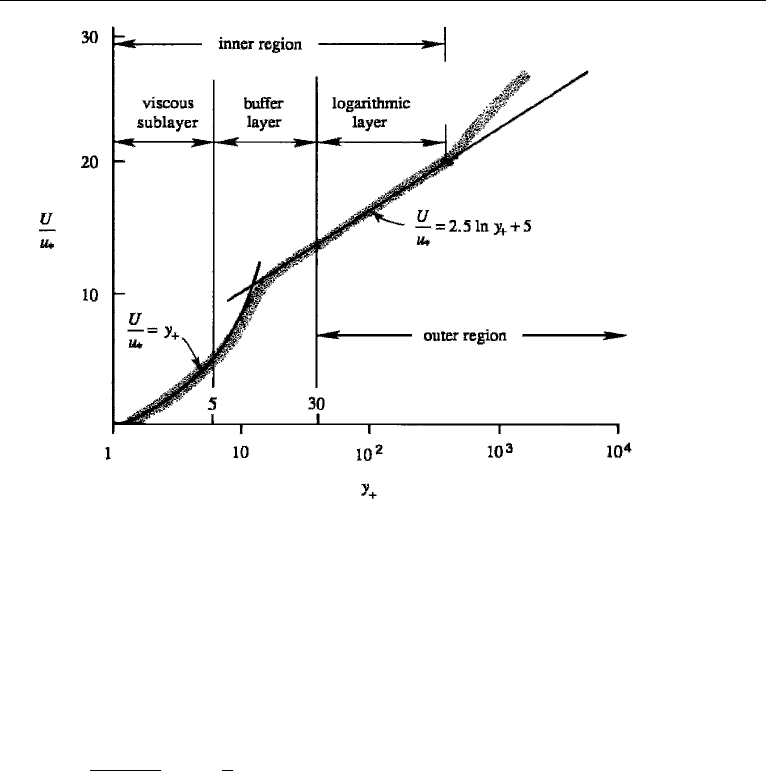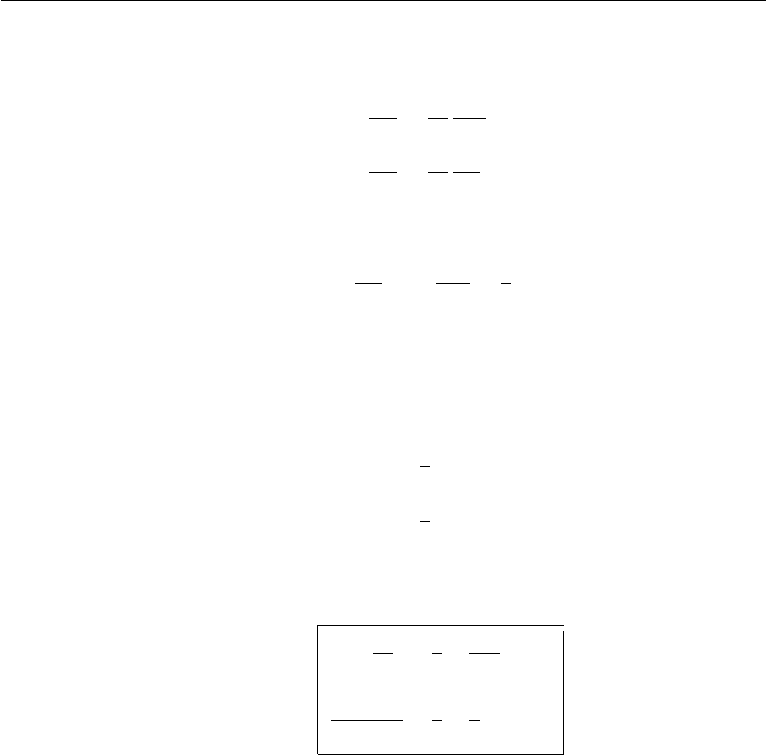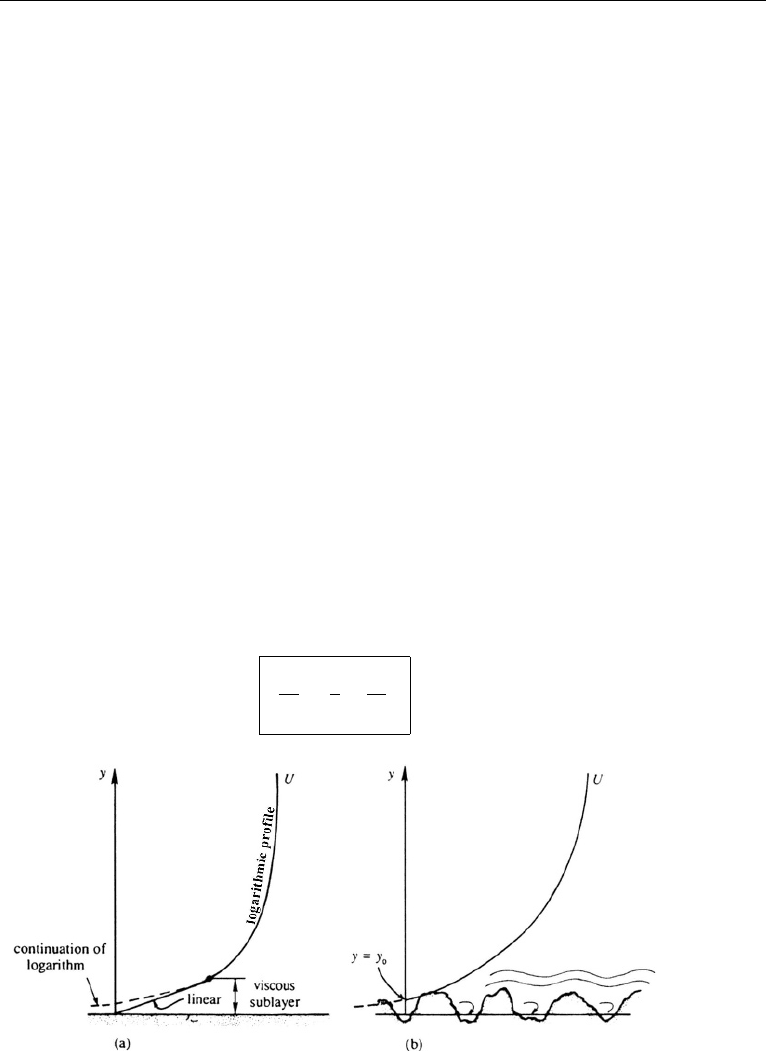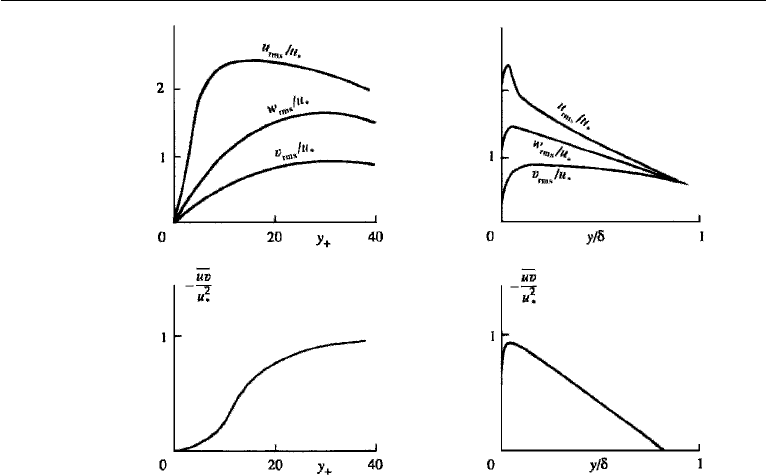Cohen I.M., Kundu P.K. Fluid Mechanics
Подождите немного. Документ загружается.


572 Turbulence
where τ
0
is the shear stress at the wall. To express equation (13.47) in terms of
dimensionless variables, note that only ρ and τ
0
involve the dimension of mass, so
that these two variables must always occur together in any nondimensional group.
The important ratio
u
∗
≡
τ
0
ρ
,
(13.48)
has the dimension of velocity and is called the friction velocity. Equation (13.47) can
then be written as
U = U(u
∗
,ν,y). (13.49)
This relates four variables involving only the two dimensions of length and time.
According to the pi theorem (Chapter 8, Section 4) there must be only 4 − 2 = 2
nondimensional groups U/u
∗
and yu
∗
/ν, which should be related by some universal
functional form
U
u
∗
= f
yu
∗
ν
= f(y
+
) (law of the wall), (13.50)
where y
+
≡ yu
∗
/ν is the distance nondimensionalized by the viscous scale ν/u
∗
.
Equation (13.50) is called the law of the wall, and states that U/u
∗
must be a universal
function of yu
∗
/ν near a smooth wall.
The inner part of the wall layer, right next to the wall, is dominated by viscous
effects (Figure 13.18) and is called the viscous sublayer. It used to be called the
“laminar sublayer,” until experiments revealed the presence of considerable fluctu-
ations within the layer. In spite of the fluctuations, the Reynolds stresses are still
small here because of the dominance of viscous effects. Because of the thinness of
the viscous sublayer, the stress can be taken as uniform within the layer and equal
to the wall shear stress τ
0
. Therefore the velocity gradient in the viscous sublayer is
given by
µ
dU
dy
= τ
0
,
which shows that the velocity distribution is linear. Integrating, and using the no-slip
boundary condition, we obtain
U =
yτ
0
µ
.
In terms of nondimensional variables appropriate for a wall layer, this can be written as
U
u
∗
= y
+
(viscous sublayer). (13.51)
Experiments show that the linear distribution holds up to yu
∗
/ν ∼ 5, which may be
taken to be the limit of the viscous sublayer.

11. Wall-Bounded Shear Flow 573
Figure 13.18 Law of the wall. A typical data cloud is shaded.
Outer Layer: Velocity Defect Law
We now explore the form of the velocity distribution in the outer part of a turbulent
layer. The gross characteristics of the turbulence in the outer region are inviscid and
resemble those of a wall-free turbulent flow. The existence of Reynolds stresses in the
outer region results in a drag on the flow and generates a velocity defect (U
∞
− U),
which is expected to be proportional to the wall friction characterized by u
∗
. It follows
that the velocity distribution in the outer region must have the form
U − U
∞
u
∗
= F
y
δ
= F(ξ) (velocity defect law), (13.52)
where ξ ≡ y/δ. This is called the velocity defect law.
Overlap Layer: Logarithmic Law
The velocity profiles in the inner and outer parts of the boundary layer are governed
by different laws (13.50) and (13.52), in which the independent variable y is scaled
differently. Distances in the outer part are scaled by δ, whereas those in the inner part
are measured by the much smaller viscous scale ν/u
∗
. In other words, the small dis-
tances in the inner layer are magnified by expressing them as yu
∗
/ν. This is the typical
behavior in singular perturbation problems (see Chapter 10, Sections 14 and 16). In
these problems the inner and outer solutions are matched together in a region of over-
lap by taking the limits y
+
→∞and ξ → 0 simultaneously. Instead of matching
velocity, in this case it is more convenient to match their gradients. (The derivation

574 Turbulence
given here closely follows Tennekes and Lumley (1972).) From equations (13.50)
and (13.52), the velocity gradients in the inner and outer regions are given by
dU
dy
=
u
2
∗
ν
df
dy
+
, (13.53)
dU
dy
=
u
∗
δ
dF
dξ
. (13.54)
Equating (13.53) and (13.54) and multiplying by y/u
∗
, we obtain
ξ
dF
dξ
= y
+
df
dy
+
=
1
k
, (13.55)
valid for large y
+
and small ξ . As the left-hand side can only be a function of ξ and
the right-hand side can only be a function of y
+
, both sides must be equal to the same
universal constant, say 1/k, where k is called the von Karman constant. Experiments
show that k 0.41. Integration of equation (13.55) gives
f(y
+
) =
1
k
ln y
+
+ A,
F(ξ) =
1
k
ln ξ +B.
(13.56)
Experiments show that A = 5.0 and B =−1.0 for a smooth flat plate, for which
equations (13.56) become
U
u
∗
=
1
k
ln
yu
∗
ν
+ 5.0,
U − U
∞
u
∗
=
1
k
ln
y
δ
− 1.0.
(13.57)
(13.58)
These are the velocity distributions in the overlap layer, also called the inertial sub-
layer or simply the logarithmic layer. As the derivation shows, these laws are only
valid for large y
+
and small y/δ.
The foregoing method of justifying the logarithmic velocity distribution near a
wall was first given by Clark B. Millikan in 1938, before the formal theory of singular
perturbation problems was fully developed. The logarithmic law, however, was known
from experiments conducted by the German researchers, and several derivations based
on semiempirical theories were proposed by Prandtl and von Karman. One such
derivation by the so-called mixing length theory is presented in the following section.
The logarithmic velocity distribution near a surface can be derived solely on
dimensional grounds. In this layer the velocity gradient dU/dy can only depend on
the local distance y and on the only relevant velocity scale near the surface, namely u
∗
.
(The layer is far enough from the wall so that the direct effect of ν is not relevant
and far enough from the outer part of the turbulent layer so that the effect of δ is not

11. Wall-Bounded Shear Flow 575
relevant.) A dimensional analysis gives
dU
dy
=
u
∗
ky
,
where the von Karman constant k is introduced for consistency with the preceding
formulas. Integration gives
U =
u
∗
k
ln y + const. (13.59)
It is therefore apparent that dimensional considerations alone lead to the logarithmic
velocity distribution near a wall. In fact, the constant of integration can be adjusted
to reduce equation (13.59) to equation (13.57) or (13.58). For example, matching the
profile to the edge of the viscous sublayer at y = 10.7ν/u
∗
reduces equation (13.59)
to equation (13.57) (Exercise 8). The logarithmic velocity distribution also applies to
rough walls, as discussed later in the section.
The experimental data on the velocity distribution near a wall is sketched in
Figure 13.18. It is a semilogarithmic plot in terms of the inner variables. It shows that
the linear velocity distribution (13.51) is valid for y
+
< 5, so that we can take the
viscous sublayer thickness to be
δ
ν
5ν
u
∗
(viscous sublayer thickness).
The logarithmic velocity distribution (13.57) is seen to be valid for 30 <y
+
< 300.
The upper limit on y
+
, however, depends on the Reynolds number and becomes
larger as Re increases. There is therefore a large logarithmic overlap region in flows
at large Reynolds numbers. The close analogy between the overlap region in physical
space and inertial subrange in spectral space is evident. In both regions, there is little
production or dissipation; there is simply an “inertial” transfer across the region by
inviscid nonlinear processes. It is for this reason that the logarithmic layer is called
the inertial sublayer.
As equation (13.58) suggests, a logarithmic velocity distribution in the overlap
region can also be plotted in terms of the outer variables of (U − U
∞
)/u
∗
vs y/δ.
Such plots show that the logarithmic distribution is valid for y/δ < 0.2. The loga-
rithmic law, therefore, holds accurately in a rather small percentage (∼20%) of the
total boundary layer thickness. The general defect law (13.52), where F(ξ) is not
necessarily logarithmic, holds almost everywhere except in the inner part of the wall
layer.
The region 5 <y
+
< 30, where the velocity distribution is neither linear nor
logarithmic, is called the buffer layer. Neither the viscous stress nor the Reynolds
stress is negligible here. This layer is dynamically very important, as the turbulence
production −
uv(dU/dy) reaches a maximum here due to the large velocity gradients.
Wosnik et al. (2000) very carefully reexamined turbulent pipe and channel flows
and compared their results with superpipe data and scalings developed by Zagarola
and Smits (1998), and others. Very briefly, Figure 13.18 is split into more regions

576 Turbulence
in that a “mesolayer” is required between the buffer layer and the inertial sublayer.
Proper description of the velocity in this mesolayer requires an offset parameter in the
logarithm of equations (13.56). This is obtained by generalizing equation (13.55) to
(ξ +¯a)
dF
d(ξ +¯a)
= (y
+
+ a
+
)
df
d(y
+
+ a
+
)
=
1
k
,
where ¯a = a/δ, a
+
= au
∗
/ν.
Equations (13.56) become
f(y
+
) = k
−1
ln(y
+
+ a
+
) + A,
F(ξ) = k
−1
ln(ξ +¯a) +B.
The value for a
+
suggested by Wosnik et al. that best fits the superpipe data is
a
+
=−8.
A more rational asymptotic treatment was given by Buschmann and Gad-el-Hak
(2003a) in terms of an expansion for large Karman number δ
+
=
(C
f
/2)·(δ/θ )Re
θ
in the case of a zero pressure gradient turbulent boundary layer. Here C
f
is the
skin friction coefficient defined in (10.38) and θ is the momentum thickness defined
in (10.17). Re
θ
is the Reynolds number based on the local momentum thickness of
the boundary layer. The second author had previously found δ
+
= 1.168(Re
θ
)
.875
empirically over a wide range of Re. U/u
∗
is expanded in both the inner layer (y
+
)
and the outer layer (η = y/δ) in negative powers of δ
+
. To lowest order we recover the
simple log velocity profile [(13.59)]. Higher-order terms include powers of the inner
and outer variables. After matching in an overlap region, the remaining coefficients
are ultimately determined by comparison with experiments. Comparing with alter-
native forms for the turbulent velocity profiles, Buschmann and Gad-el-Hak (2003b)
conclude that the generalized log law gives a better fit over an extended range of y
+
than any alternative velocity profile. Also, as Re
θ
increases, the higher-order terms in
the Karman number expansion become asymptotically small.
The outer region of turbulent boundary layers (y
+
> 100) is the subject of a
similarity analysis by Castillo and George (2001). They found that 90% of a turbu-
lent flow under all pressure gradients is characterized by a single pressure gradient
parameter,
=
δ
ρU
2
∞
dδ/dx
dp
∞
dx
.
A requirement for “equilibrium” turbulent boundary layer flows, to which their anal-
ysis is restricted, is that = const., and this leads to similarity. Examination of
data from many sources led them to conclude that “...there appear to be almost
no flows that are not in equilibrium ....” Their most remarkable result is that only
three values of correlate the data for all pressure gradients: = 0.22 (adverse
pressure gradients); =−1.92 (favorable pressure gradients); and = 0 (zero
pressure gradient). A direct consequence of = const. is that δ(x) ∼ U
−1/
∞
. Data
was well correlated by this result for both favorable and adverse pressure gradients.
Walker and Castillo (2002) then correlated velocity defect profiles for favorable, zero,

11. Wall-Bounded Shear Flow 577
and adverse pressure gradients by plotting
[
(U
∞
− U)/U
∞
]
(δ
∗
/δ
99
) vs. y/δ
99
. (See
Section 10.3 for the definitions of δ
99
and δ
∗
). Remarkably, only three distinct tur-
bulent velocity profiles resulted. This correlation of data with only three values of
was contested by Maciel, Rossignol, and Lemay (2006) in their examination of
data bases for adverse pressure gradient turbulent boundary layers. They found that
scalings developed by Zagarola and Smits (1998) worked best but that varied by a
factor of 2 (from 0.16 to 0.33), while in each of the flows was held constant and
the flow was observed to be self-similar. The value of = 0.22 held for only two
of the nine adverse pressure gradient data sets listed by Maciel et al. Moreover, the
velocity defect profiles for adverse pressure gradient flows did not collapse onto a
single limiting profile, as asserted by Walker and Castillo.
Very close to separation, the boundary layer assumptions that ∂/∂x ∂/∂y and
v u break down and new scalings become necessary as discussed in Indinger,
Buschmann, and Gad-el-Hak (2006).
A review paper by W. K. George (2006) puts much of the analysis and discussion
into a wide-view perspective. Three scalings for the outer 90% of the zero pressure
gradient turbulent velocity deficit profiles are written, the first a generalization of
Eq. (13.52) to include behavior with δu
∗
/ν. The second is of the same form but the
normalization is by U
∞
instead of u
∗
. The third scaling is of the form of the second
with the functional behavior prefaced by δ
∗
/δ, where the displacement thickness
δ
∗
is defined in Eq. (10.16). The first scaling gives the logarithmic behavior in the
overlap between the inner and outer regions of the turbulent boundary layer whereas
the second gives a power law.
Professor George pointed out that although the momentum integral equation for
constant pressure turbulent boundary layers [Eq. (10.44)] holds, dθ/dx = (u
∗
/U
∞
)
2
,
and the main contribution to θ [momentum thickness, Eq. (10.17)] comes from near
wall regions, almost the entire value of dθ/dx comes from distances far from the
wall.
The third scaling is due to Zagarola and Smits (1998) and can reduce to either
of the first two depending on the Re →∞asymptotic behavior. If δ
∗
/δ → u
∗
/U
∞
,
then the first scaling leading to a logarithmic overlap is obtained. If, on the other
hand, δ
∗
/δ → const., then the second scaling leading to a power law is found. Here
the limit Re →∞must be taken as x →∞downstream with fixed upstream and
external conditions. It is also shown here that the logarithmic overlap is the lowest
order in an expansion of the power law. The two results are very close largely because
du/dy ∼ 1/y
1
yields a logarithm (upon integration) but du/dy ∼ 1/y
γ
where γ is
anything other than = 1 but may be very close to 1, yields a power upon integration.
Since the latter is more general and results from a difference in turbulence scales in
the two regions involved in the overlap, it is likely to be correct, but more detailed
and careful data is required to distinguish the two forms.
It is easier to discuss the details of the balance among regions of turbulence for
a planar fully developed pressure driven turbulent shear flow. Consider a flow in the
x-direction between two parallel plates at y = 0 and y = 2δ that is no longer evolving
in the x-direction. The convective acceleration terms are then identically zero and the
x-momentum equation reduces to −∂P/∂x +d/dy(µ∂U/∂y −ρ
0
uv) = 0 . Since the

578 Turbulence
pressure gradient is constant in x, it must be balanced by the shear stress on the two
walls over any distance L, which yields the equality τ
0
=−δ ·∂P/∂x. Then with the
dimensionless variables, U/u
∗
= u
+
, yu
∗
/ν = y
+
, δu
∗
/v = δ
+
,(uv)/u
2
∗
= (uv)
+
,
the x-momentum equation becomes δ
−1
+
+ d
2
u
+
/dy
2
+
− d/dy(uv)
+
= 0, represent-
ing a balance among the pressure gradient, viscous stress gradient, and Reynolds
stress gradient. This is the starting point of the analysis by Fife, Wei, Klewicki, and
McMurtry (2005). The authors find distinct scalings representing different balances
of terms. These are described by the following in order of increasing distance from
the wall. For y
+
< 3, there is the sublayer where the viscous stress gradient balances
the mean pressure gradient, and the Reynolds stress gradient is small by comparison.
As we go outwards from the wall, the viscous stress gradient balances the Reynolds
stress gradient. For large enough Re this layer extends into the logarithmic region of
the earlier models. Near the location of maximum Reynolds stress, since the Reynolds
stress gradient is small, the viscous stress gradient and pressure gradient are again in
balance. This is true despite the Reynolds stress being much larger than the viscous
stress. This region is called the viscous/pressure gradient mesolayer. Still further from
the wall the Reynolds stress gradient and pressure gradient are in balance.
Wei, Fife, and Klewicki (2007) codified this analysis for any combination of
Couette and Poiseuille flows. We will concentrate on the latter. Explicitly, the inner
normalized equations are written in terms of u
+
and y
+
. The innermost viscous layer
is then a simple generalization of Eq. (13.51) to include the pressure gradient. The
balance of the inner normalized equations is between the viscous and Reynolds stress
gradients. The outer normalization retains u
+
but uses ξ = y/δ as the outer length
scale. In the outermost region, the Reynolds stress and pressure gradients balance
giving: 1 − d/dξ(
uv)
+
= O(δ
−1
+
) → 0. Between these, in the neighborhood of
maximum Reynolds stress, there is a mesolayer in which all terms are in balance.
This is scaled by:
ˆ
y = (y
+
− y
m+
)δ
−1/2
+
,(
uv) = δ
1/2
+
(
uv)
+
− (uv)
m+
,
ˆ
u(
ˆ
y)
= u
+
− u
m+
− (du
+
/dy
+
)
m
·(y
+
− y
m+
).
Here, all ˆvariables are finite in the limit δ
+
≡ Re
∗
→∞. Although the location y
m+
and the value of (uv)
m+
are not known a priori, good approximations are obtained if
y
m+
δ
−1/2
+
= 1 and (uv)
m+
= 1.
Fife et al. (2005) and Wei et al. (2007) introduced the notion of scaling patches
such that a patch is “...defined to be a region in the flow field specified by an interval
of distance from the wall, together with a scaling or non-dimensionalization of the
variables which is natural for that region.” Here “natural” means that in appropriately
normalized variables, the data within that region are independent of Reynolds number
in the turbulent limit, Re →∞. The authors assert that knowledge of the local
scaling properties of the mean momentum and Reynolds stress profiles is essential to
understanding wall bounded turbulent flows. The scaling to render all three terms in
the mean momentum balance of the same order (in Re or δ
+
) in the neighborhood
of the Reynolds stress maximum is indeterminate, leaving one free parameter. All
coefficients are = 1 in the Re →∞limit in this patch centered about the Reynolds

11. Wall-Bounded Shear Flow 579
stress maximum. A very special choice of this free parameter leads to a logarithm
for u
+
; any other choice gives power law growth. A different scaling patch may be
found in the neighborhood of the channel centerline, again with one free parameter.
A very special choice of the free parameter results in the classical defect law for the
outermost layer.
Rough Surface
In deriving the logarithmic law (13.57), we assumed that the flow in the inner layer
is determined by viscosity. This is true only in hydrodynamically smooth surfaces,
for which the average height of the surface roughness elements is smaller than the
thickness of the viscous sublayer. For a hydrodynamically rough surface, on the other
hand, the roughness elements protrude out of the viscous sublayer. An example is
the flow near the surface of the earth, where the trees and buildings act as rough-
ness elements. This causes a wake behind each roughness element, and the stress is
transmitted to the wall by the “pressure drag” on the roughness elements. Viscosity
becomes irrelevant for determining either the velocity distribution or the overall drag
on the surface. This is why the drag coefficients for a rough pipe and a rough flat
surface become independent of the Reynolds number as Re →∞.
The velocity distribution near a rough surface is again logarithmic, although it
cannot be represented by equation (13.57). To find its form, we start with the general
logarithmic law (13.59). The constant of integration can be determined by noting that
the mean velocity U is expected to be negligible somewhere within the roughness
elements (Figure 13.19b). We can therefore assume that (13.59) applies for y>y
0
,
where y
0
is a measure of the roughness heights and is defined as the value of y at
which the logarithmic distribution gives U = 0. Equation (13.59) then gives
U
u
∗
=
1
k
ln
y
y
0
. (13.60)
Figure 13.19 Logarithmic velocity distributions near smooth and rough surfaces: (a) smooth wall; and
(b) rough wall.

580 Turbulence
Figure 13.20 Sketch of observed variation of turbulent intensity and Reynolds stress across a channel
of half-width δ. The left panels are plots as functions of the inner variable y
+
, while the right panels are
plots as functions of the outer variable y/δ.
Variation of Turbulent Intensity
The experimental data of turbulent intensity and Reynolds stress in a channel flow are
given in Townsend (1976). Figure 13.20 shows a schematic representation of these
data, plotted both in terms of the outer and the inner variables. It is seen that the
turbulent velocity fluctuations are of order u
∗
. The longitudinal fluctuations are the
largest because the shear production initially feeds the energy into the u-component;
the energy is subsequently distributed into the lateral components v and w. (Inciden-
tally, in a convectively generated turbulence the turbulent energy is initially fed to the
vertical component.) The turbulent intensity initially rises as the wall is approached,
but goes to zero right at the wall in a very thin wall layer. As expected from phys-
ical considerations, the normal component v
rms
starts to feel the wall effect earlier.
Figure 13.20 also shows that the distribution of each variable very close to the wall
becomes clear only when the distances are magnified by the viscous scaling ν/u
∗
.
The Reynolds stress profile in terms of the inner variable shows that the stresses are
negligible within the viscous sublayer (y
+
< 5), beyond which the Reynolds stress
is nearly constant throughout the wall layer. This is why the logarithmic layer is also
called the constant stress layer.
12. Eddy Viscosity and Mixing Length
The equations for mean motion in a turbulent flow, given by equation (13.24), cannot
be solved for U
i
(x) unless we have an expression relating the Reynolds stresses

12. Eddy Viscosity and Mixing Length 581
u
i
u
j
in terms of the mean velocity field. Prandtl and von Karman developed certain
semiempirical theories that attempted to provide this relationship.
These theories are based on an analogy between the momentum exchanges both
in turbulent and in laminar flows. Consider first a unidirectional laminar flow U(y),
in which the shear stress is
τ
lam
ρ
= ν
dU
dy
, (13.61)
where ν is a property of the fluid.According to the kinetic theory of gases, the diffusive
properties of a gas are due to the molecular motions, which tend to mix momentum
and heat throughout the flow. It can be shown that the viscosity of a gas is of order
ν ∼ aλ, (13.62)
where a is the rms speed of molecular motion, and λ is the mean free path defined as
the average distance traveled by a molecule between collisions. The proportionality
constant in equation (13.62) is of order 1.
One is tempted to speculate that the diffusive behavior of a turbulent flow may
be qualitatively similar to that of a laminar flow and may simply be represented by a
much larger diffusivity. By analogy with (13.61), Boussinesq proposed to represent
the turbulent stress as
−
uv = ν
e
dU
dy
, (13.63)
where ν
e
is the eddy viscosity. Note that, whereas ν is a known property of the fluid, ν
e
in (13.63) depends on the conditions of the flow. We can always divide the turbulent
stress by the mean velocity gradient and call it ν
e
, but this is not progress unless
we can formulate a rational method for finding the eddy viscosity from other known
parameters of a turbulent flow.
The eddy viscosity relation (13.63) implies that the local gradient determines
the flux. However, this cannot be valid if the eddies happen to be larger than the
scale of curvature of the profile. Following Panofsky and Dutton (1984), consider the
atmospheric concentration profile of carbon monoxide (CO) shown in Figure 13.21.
An eddy viscosity relation would have the form
−
wc = κ
e
dC
dz
, (13.64)
where C is the mean concentration (kilograms of CO per kilogram of air), c is its
fluctuation, and κ
e
is the eddy diffusivity. A positive κ
e
requires that the flux of CO at
P be downward. However, if the thermal convection is strong enough, the large eddies
so generated can carry large amounts of CO from the ground to point P, and result in
an upward flux there. The direction of flux at P in this case is not determined by the
local gradient at P, but by the concentration difference between the surface and point
P. In this case, the eddy diffusivity found from equation (13.64) would be negative
and, therefore, not very meaningful.
